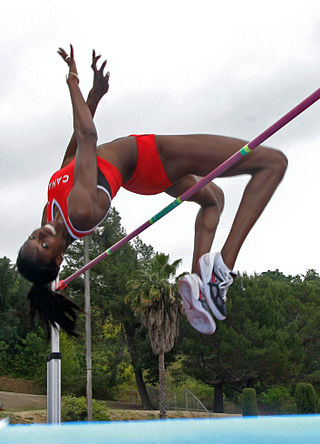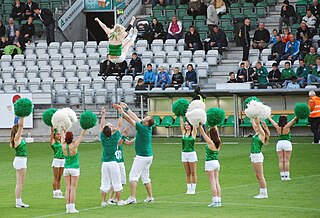
Cheerleading is an activity in which the participants cheer for their team as a form of encouragement. It can range from chanting slogans to intense physical activity. It can be performed to motivate sports teams, to entertain the audience, or for competition. Cheerleading routines typically range anywhere from one to three minutes, and contain components of tumbling, dance, jumps, cheers, and stunting. Cheerleading originated in the United States, where it has become a tradition. It is less prevalent in the rest of the world, except via its association with American sports or organized cheerleading contests.

The high jump is a track and field event in which competitors must jump unaided over a horizontal bar placed at measured heights without dislodging it. In its modern, most-practiced format, a bar is placed between two standards with a crash mat for landing. Since ancient times, competitors have introduced increasingly effective techniques to arrive at the current form, and the current universally preferred method is the Fosbury Flop, in which athletes run towards the bar and leap head first with their back to the bar.

The long jump is a track and field event in which athletes combine speed, strength and agility in an attempt to leap as far as possible from a takeoff point. Along with the triple jump, the two events that measure jumping for distance as a group are referred to as the "horizontal jumps". This event has a history in the ancient Olympic Games and has been a modern Olympic event for men since the first Olympics in 1896 and for women since 1948.

Hurdling is the act of jumping over an obstacle at a high speed or in a sprint. In the early 19th century, hurdlers ran at and jumped over each hurdle, landing on both feet and checking their forward motion. Today, the dominant step patterns are the 3-step for high hurdles, 7-step for low hurdles, and 15-step for intermediate hurdles. Hurdling is a highly specialized form of obstacle racing, and is part of the sport of athletics. In hurdling events, barriers known as hurdles are set at precisely measured heights and distances. Each athlete must pass over the hurdles; passing under or intentionally knocking over hurdles will result in disqualification.
Because ballet became formalized in France, a significant part of ballet terminology is in the French language.
Professional wrestling holds include a number of set moves and pins used by performers to immobilize their opponents or lead to a submission. This article covers the various pins, stretches and transition holds used in the ring. Some wrestlers use these holds as their finishing maneuvers, often nicknaming them to reflect their character or persona. Moves are listed under general categories whenever possible.

The Fosbury flop is a jumping style used in the track and field sport of high jump. It was popularized and perfected by American athlete Dick Fosbury, whose gold medal in the 1968 Summer Olympics in Mexico City brought it to the world's attention. The flop became the dominant style of the event; before Fosbury, most elite jumpers used the straddle technique, Western Roll, Eastern cut-off, or scissors jump to clear the bar. Though the backwards flop technique had been known for years before Fosbury, landing surfaces had been sandpits or low piles of matting and high jumpers had to land on their feet or at least land carefully to prevent injury. With the advent of deep foam matting, high jumpers were able to be more adventurous in their landing styles and hence more experimental with jumping styles.
Trampolining terms are used to describe various positions and types of skill performed in the sport of trampolining.

In professional wrestling, a pin is a move where a wrestler holds an opponent's shoulders to the mat in an attempt to score a fall. A pinfall is a common victory condition, where the attacker pins an opponent and the referee makes a three count before the opponent gets released from the pin.

A split is a physical position in which the legs are in line with each other and extended in opposite directions. Splits are commonly performed in various athletic activities, including dance, figure skating, gymnastics, contortionism, synchronized swimming, cheerleading, martial arts, aerial arts and yoga as exercise, where a front split is named Hanumanasana and a side split is named Samakonasana. A person who has assumed a split position is said to be "in a split", or "doing the splits", or "doing a split".

The straddle technique was the dominant style in the high jump before the development of the Fosbury Flop. It is a successor of the Western roll, for which it is sometimes confused.
The following is a glossary of figure skating terms, sorted alphabetically.
A cheerleading uniform is a standardized outfit worn by cheerleaders during games and other events. These uniforms typically include the official colors and mascots of the school or team and are designed to make the wearer appear physically attractive.

Arabesque in dance, particularly ballet, is a body position in which a dancer stands on one leg–the supporting leg–with the other leg–the working leg–turned out and extended behind the body, with both legs held straight.

A Basket Toss is a stunt performed in cheerleading using 3 or more bases to toss a flyer into the air. Two of the bases interlock their hands. While in the air, the flyer does some type of jump, ranging from toe-touches to herkies before returning to the cradle.
Lawrence Russell Herkimer was an American innovator in the field of cheerleading. He created the Herkie cheerleading jump, which was named after him, and received a patent for the pom-pom. Herkimer described his contribution to the field as taking it "from the raccoon coat and pennant to greater heights".
The US National Cheerleaders Association (NCA) was established as a way to bring cheerleaders together to learn new skills. Since 1951, the NCA has held summer camps, and is credited with the invention of the herkie jump, the pom pom, the spirit stick and being the first uniform manufacturer.










